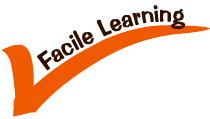Products
Perfect for classroom teaching and for individual student-learning.
Facile Learning programs takes you step-by-step, click-by-click,
through each topic.
A minimum $1000 fee includes accounts for all teachers in all grades, in addition to 100 student accounts.
Additional student accounts are $10 per student.
Quebec Secondary I-III: Science and Technology
Quebec Secondary IV: Science and Technology (Basic)
Quebec Secondary IV: Environmental Science and Technology (Advanced)
Science and Technology - Grade 7 to 9 Click to view program correlation document
|
Lesson
1: Chemistry Lesson
2: Properties Lesson
3: Concentration and dilution Lesson
4: The cell |
Lesson
5: Biological systems Lesson
6: Eye, light and heat Lesson
7: Ecosystems Lesson
8: Earth
|
Lesson
9: Geological timescale and evolution Lesson
10: Energy and resources Lesson
11: Space Lesson
12: Forces Lesson
13: Technology |
Science
and Technology - Grade 10 (Basic) Click
to view Quebec program correlation document
| Lesson
1: Organization of Matter Lesson 2: Physical
and Chemical Changes |
Lesson
3: Solutions Lesson 5: Magnetism |
Lesson
6: Earth, Space and Ecology Lesson
7: Energy and the environment Lesson
8: Material and Mechanical Engineering |
Environmental
Science and Technology - Grade 10 (Advanced) Click to view program correlation document
| Lesson
9 : Atoms Lesson 10 : Bonding Lesson 11 : Changes
of matter
|
Lesson
12: Mole and Stoichiometry Lesson 13 : Acids and
Bases Lesson 14: Transformation
of energy |
Lesson
15: Electricity, Magnetism and Technology Lesson
16: Earth, Space and the Living World |
